Why is it important to waterproof bathrooms and toilets?
Bathrooms and restrooms are among the areas constantly exposed to moisture and water. Without proper waterproofing, various problems can arise—one of the most significant being water infiltration into walls and floors, which over time can lead to structural damage, peeling tiles, and even a weakened foundation. Minor leaks might seem unimportant at first, but they often lead to bigger issues like mold and mildew growth. This not only gives the bathroom an unpleasant appearance but can also pose health risks to the occupants.
Excessive moisture also damages bathroom fixtures and fittings. Cabinets, sinks, and even electrical appliances in the space can suffer from rust and decay due to constant water exposure. Therefore, waterproofing the bathroom not only extends the life of the structure and its components but also helps prevent unnecessary repair and replacement costs.
In this article, we’ll explore the best waterproofing methods for bathrooms and restrooms—so you can confidently create a safe, beautiful, and long-lasting space for yourself and your family.
Different materials and methods for waterproofing a bathroom
When it comes to waterproofing a bathroom, choosing the right materials and methods is very important. The materials used in insulation should be able to repel moisture and prevent water from penetrating the structure. Some of the best insulation materials include:
Polymer-based sealants: These materials are made from water-resistant chemical compounds and are considered one of the best options for waterproofing bathrooms. Polymer coatings are highly flexible and resistant to temperature changes.
Nano coatings: Nanotechnology has brought a major revolution to the insulation industry. Nano coatings waterproof the surface of tiles and walls, preventing moisture penetration. This method offers high performance and greater longevity compared to many traditional waterproofing solutions.
- Bitumen and membrane (isogam): This traditional method is still used in some cases but requires more maintenance than newer alternatives. isogam is applied to floors or walls to prevent water from seeping into the inner layers of the building.
In terms of cost, nano coatings and polymer-based sealants may initially seem more affordable, yet they offer greater durability and help reduce the need for frequent repairs. On the other hand, bitumen-based methods like isogam and qirgooni typically come with a lower upfront cost, but may require more maintenance and replacement over time.
Choosing the right method depends on your budget, building type, and the level of humidity in the environment. In the following section, we’ll explore specific waterproofing techniques for different parts of the bathroom.
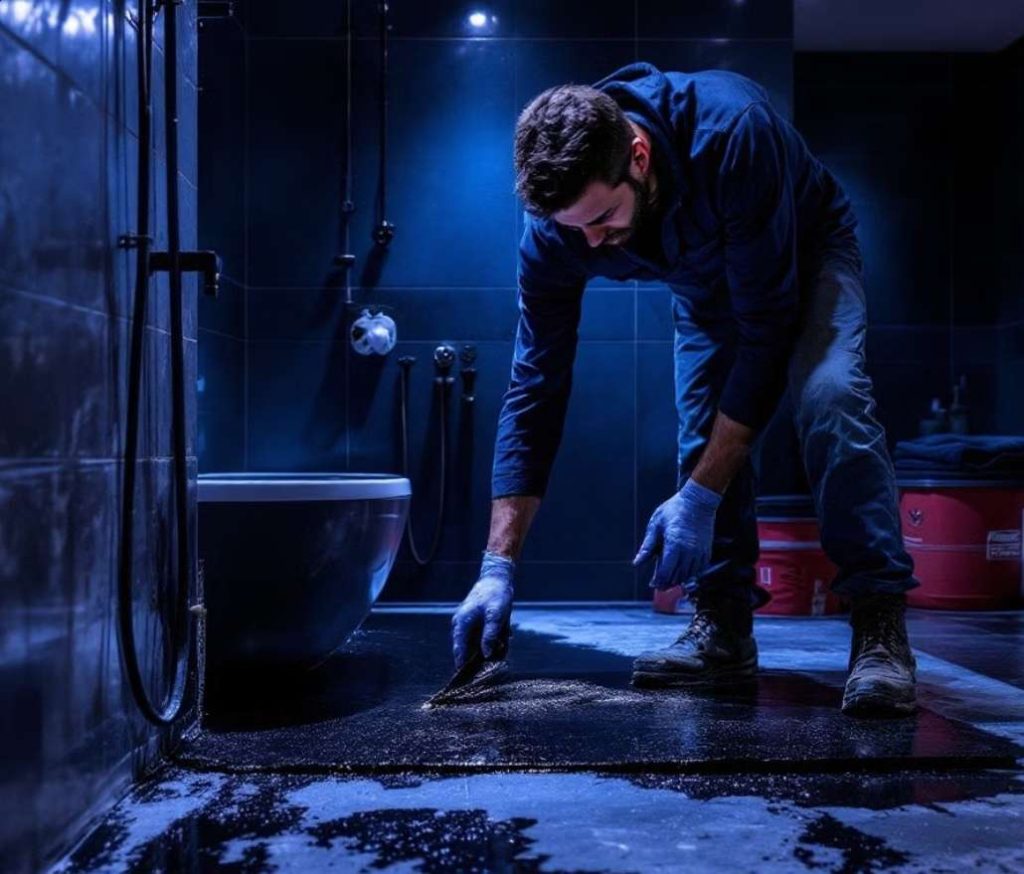
Waterproofing a Bathroom Floor: Best Methods
The bathroom floor has the most direct contact with water, and if not properly waterproofed, issues such as water leakage to lower floors, gradual damage to tiles, and mold growth in grout lines can occur. To prevent these problems, it’s essential to use reliable waterproofing methods for the floor.
1- Using waterproof mortar and waterproofing materials
During bathroom construction or renovation, applying special waterproof mortars beneath the tiles is one of the most effective ways to prevent water leakage. These mortars, made with polymer and water-resistant cement compounds, block moisture from reaching the underlying layers. Additionally, reinforced waterproof grouts are applied between the tiles to completely seal all gaps.
2- Choosing moisture-resistant tiles
Not all tiles are suitable for humid environments. The best options for bathroom floors are porcelain tiles or natural stones with low water absorption. These materials offer high durability and excellent resistance against temperature changes and moisture. Glazed tiles with a smooth surface are also a good choice, as they are less prone to water absorption and mold growth.
3- The importance of proper slope for water drainage
Even with the best waterproofing materials, improper slope can cause water to accumulate on the bathroom floor, increasing the risk of leaks and damage. The floor slope must be properly designed to easily direct water toward the drain. This is usually achieved using cement mortar and precise tile leveling.
Waterproofing bathroom walls not only enhances the durability of the structure but also keeps the space clean and free from moisture stains. In the next section, we will cover ceiling waterproofing in bathrooms.
Bathroom ceiling insulation and water leakage prevention
The bathroom ceiling is often an overlooked area when it comes to waterproofing, but if not properly protected, it can lead to serious issues. Moisture from steam can gradually cause yellow stains, peeling paint, and even water leakage to upper or lower floors. To prevent these problems, the following methods are recommended:
Choosing the right materials to prevent ceiling moisture Using special waterproof paints designed for bathrooms is one of the most effective ways to protect the ceiling. Nano acrylic paints and moisture-resistant plastic paints are ideal options. These paints are not only resistant to humidity but also have antibacterial properties that prevent mold growth on the ceiling.
Practical Methods for Waterproofing the Bathroom Ceiling
Using Nano Coatings:
This modern technology makes the ceiling surface waterproof and prevents moisture absorption from steam.
Installing Waterproof False Ceilings:
PVC or aluminum false ceilings not only add beauty but also offer high resistance against humidity, protecting the main ceiling from damage.

Ensuring Proper Ventilation:
One major cause of ceiling moisture is poor ventilation. Installing a powerful exhaust fan and using ventilation windows help reduce humidity and prevent water stains from forming on the ceiling.
By implementing these methods, the bathroom ceiling will remain healthy for a long time and will not require costly repairs. In the next section, we will examine solutions for waterproofing bathroom doors and windows.
Waterproofing bathroom doors and windows
One of the areas most vulnerable to moisture damage is the doors and windows in bathrooms and restrooms. Using inappropriate materials or improper sealing can lead to wood swelling, hardware rusting, and a significantly reduced lifespan. To prevent these issues, the following methods are recommended:
Choosing Waterproof PVC or Aluminum Doors
Wooden doors are not resistant to humidity and will eventually swell and decay. The best options are PVC or aluminum waterproof doors, which are rust-proof, lightweight, durable, and require minimal maintenance.
Applying Sealing Strips and Silicone Caulk
To prevent moisture infiltration around doors and windows, rubber sealing strips and silicone sealants can be used. These not only block water but also help keep out dust and insects.
Installing Double-Glazed, Moisture-Resistant Windows
If the bathroom or restroom has a window, it’s best to use double-glazed UPVC windows. These windows offer excellent moisture and thermal insulation, preventing water droplets from forming on the glass.
By selecting the right doors and windows, you can avoid early deterioration and ensure longer-lasting performance.
In the next section, we will discuss how to waterproof plumbing and pipe connections.
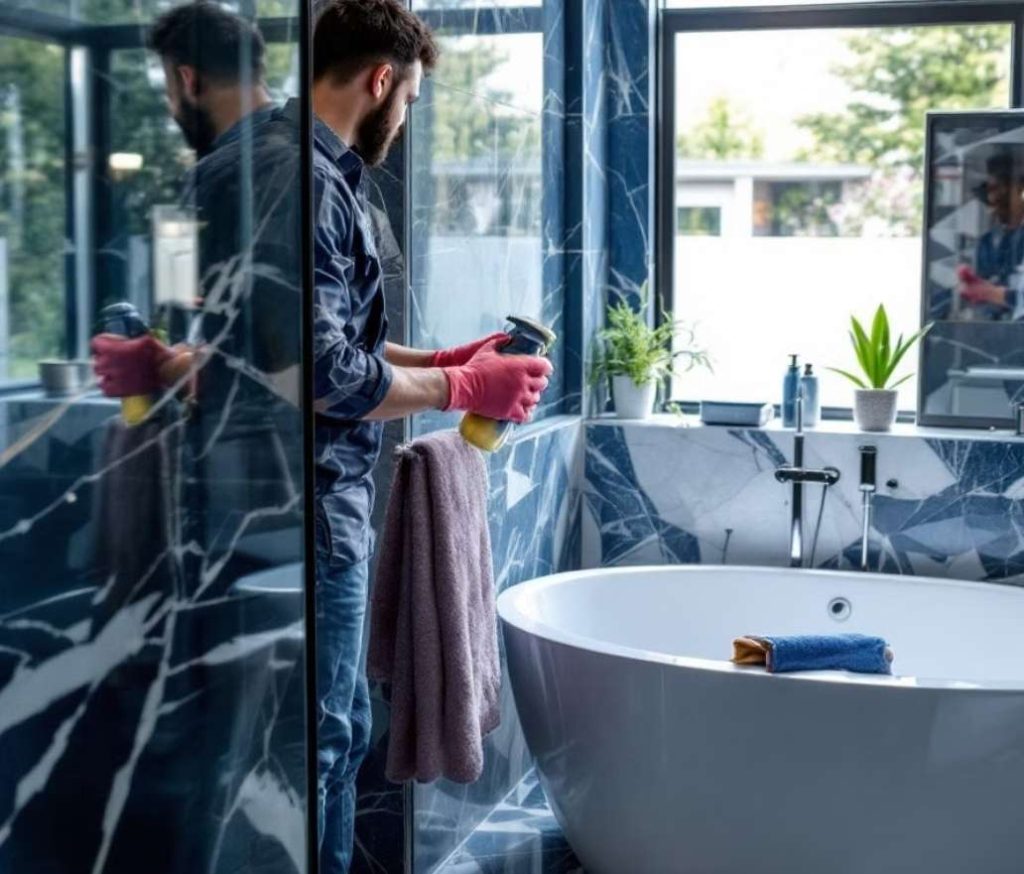
Waterproof plumbing and fittings: Preventing common leaks
One of the main causes of leakage in bathrooms is improper plumbing and poorly sealed connections. Even a small leak can gradually lead to major problems. To prevent these issues, the following strategies are recommended:
Standard Methods for Bathroom Plumbing
Use high-quality polymer pipes that offer excellent resistance to moisture and corrosion.
Choose leak-proof fittings sealed with silicone or Teflon to prevent dripping at pipe joints.
Install separate shut-off valves for the bathroom, allowing quick isolation in case of leaks.
How to Inspect and Repair Leaks
Regularly inspect pipe connections, especially in areas hidden under tiles or behind walls.
Apply sealant adhesives or Teflon tape around joints to prevent water seepage.
For major leaks, it’s best to seek help from professional plumbers to ensure proper repairs.
By following these steps, you can reduce repair costs, prevent water waste, and increase the durability of your bathroom plumbing system.
In the next section, we’ll cover additional tips for maintaining your waterproofing systems.
Additional tips and maintenance solutions for longer lasting insulation
Even when using the best waterproofing materials, proper maintenance is essential to preserve their quality over time. To extend the life of waterproof layers in your bathroom, follow these tips:
How to Inspect and Repair Potential Cracks
Regularly inspect the grout lines between tiles, and the waterproof coatings on walls and floors.
If you notice any cracks or damages in the waterproof layers, promptly repair them using waterproof grout or sealant adhesives.
Recommended Products for Better Maintenance
Use cleaning products that do not damage waterproof coatings. Avoid harsh acidic cleaners, as they can erode the layers and shorten their lifespan.
Replace silicone sealants every few years to maintain their waterproofing performance.
By following these recommendations, you can prolong the life of your bathroom’s waterproofing system and reduce the need for costly renovations.
Next, we’ll conclude the article with a summary of key points.
Using new technologies to waterproof bathrooms and toilets
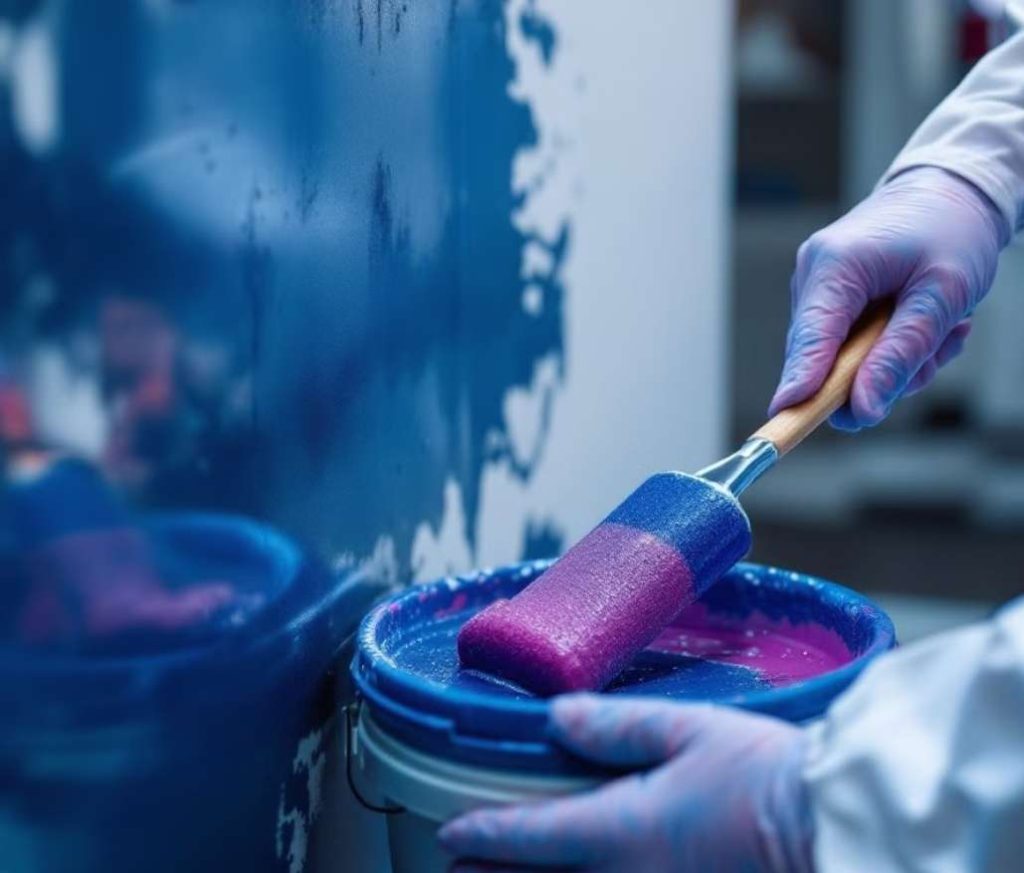
With the advancement of technology, new methods for waterproofing bathrooms and restrooms have been introduced that not only provide high performance but also offer easier installation and reduced maintenance costs. These modern technologies allow moisture and leaks to be controlled without extensive demolition.
1. Nano Waterproof Coatings and Their Benefits
One of the most modern waterproofing techniques is the use of nano coatings. These coatings form a thin, invisible layer on surfaces, preventing water penetration while maintaining breathability. Nano coatings are especially ideal for tiles, the joints between them, walls, and even bathroom glass. The key benefits include:
Preventing water and soap stains on surfaces
Increasing resistance against mold and mildew
Reducing the need for constant cleaning
2. New Sealing Systems for Increased Durability
Traditional waterproofing methods, such as bitumen and tar, have been replaced by newer systems, including liquid polymer coatings, waterproof paints, and elastomeric membranes. These new systems offer the following benefits:
High flexibility, allowing coverage of uneven surfaces
Long-lasting durability without the need for frequent repairs
Environmentally friendly, with no toxic gas emissions
Modern technologies offer options that not only improve waterproofing performance but also simplify their implementation, making it possible to benefit from them without major demolition. In the following, we will explore quick and non-destructive waterproofing methods.
How to waterproof your bathroom without major damage?
Waterproofing a bathroom is often associated with expensive processes and extensive demolition. However, there are methods that can enhance the moisture and leak resistance of surfaces without the need for a complete renovation. These methods not only save time and money but also can be applied to older bathrooms.
Quick and Cost-Effective Waterproofing Methods
Using Nano and Waterproof Paints: These coatings can easily be applied to tiles, walls, and ceilings, creating a water-resistant layer.
Resealing Joints and Gaps: Use waterproof silicones or polymer grouts to repair the joints of tiles and the gaps around the tub and shower.
Coating Surfaces with Clear Protective Layers: Some materials, such as waterproof resins and nano lacquers, act as a transparent coating on surfaces, preventing water penetration.
Implementing these methods will increase the durability of the bathroom and reduce future repair costs. Next, we will review the best waterproof brands and products available.
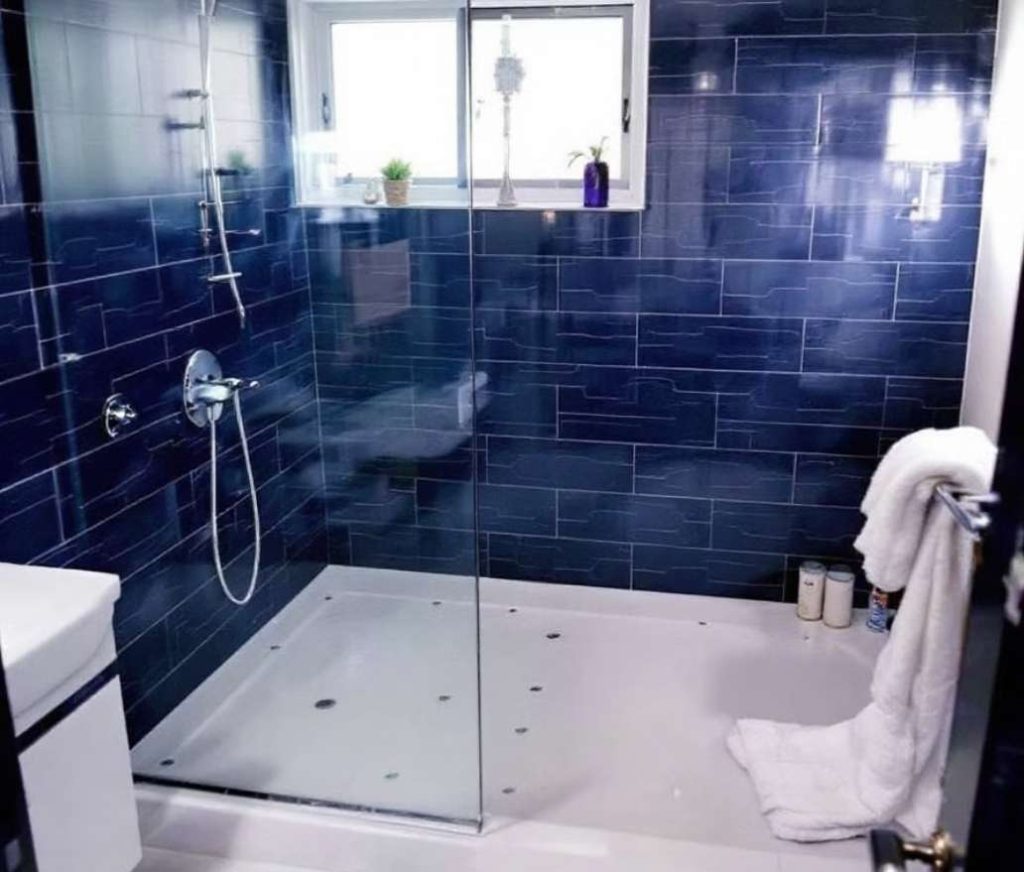
The best waterproof brands and products for bathrooms
There are a variety of products available on the market for waterproofing bathrooms and restrooms, but choosing a high-quality product with good durability is crucial. Some of the best available brands include:
Comparison of Trusted Waterproofing Brands
Sika: Offers a range of nano coatings, polyurethane coverings, and waterproofing mortars.
Mapei: Known for moisture and mold-resistant products, especially silicone sealants and waterproof mortars.
Weber: Manufacturer of polymeric coatings and adhesives resistant to water.
Features to Consider When Purchasing
High Durability and Longevity: Some products lose their sealing properties after a short period.
Resistance to Temperature Changes: Certain coatings perform differently in cold or hot areas.
Environmental Compatibility: Products with low odor and no toxic gases are better options.
By selecting products from reputable brands, you can ensure the quality of waterproofing and avoid unnecessary repair costs. Next, we will explore how waterproofing a bathroom can optimize energy consumption.
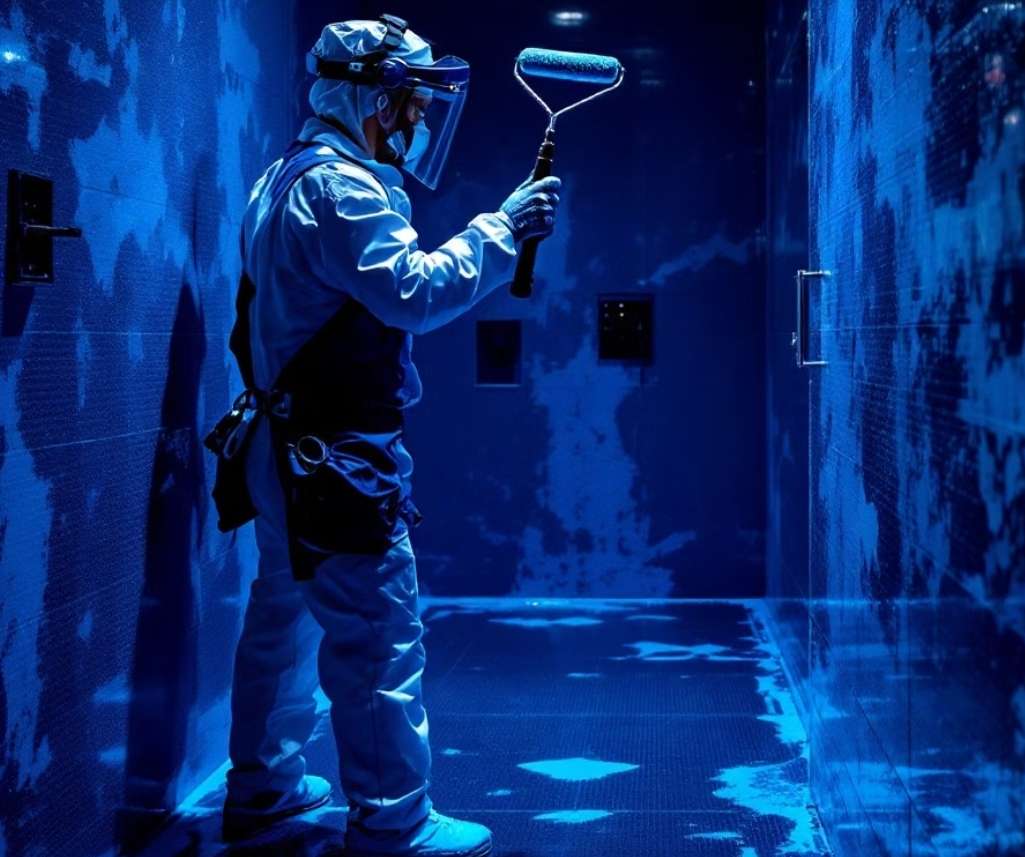
How does waterproofing a bathroom optimize energy consumption?
Proper waterproofing in the bathroom is not only limited to preventing leaks and damage, but it also has a direct impact on reducing energy consumption and heating costs. Using waterproof materials with thermal insulation properties can optimize energy usage.
Impact of Proper Waterproofing on Reducing Energy Consumption in Bathroom Heating
Floors and walls that are properly waterproofed do not absorb excess moisture, which helps retain heat in the bathroom for a longer period.
Installing waterproof doors and proper seals prevents warm air from escaping, reducing the need for heaters or heating systems.
Waterproof Materials with Thermal Insulation Properties
Some of the latest waterproofing products, such as nano-ceramic coatings and liquid thermal insulations, not only provide waterproofing but also prevent heat and cold exchange. These materials function similarly to double-glazed windows and help maintain a more stable temperature inside the bathroom.
Proper waterproofing not only increases durability and reduces repair costs but also plays an important role in reducing energy consumption. In the next section, we will explore methods for waterproofing showers and around bathtubs.
Conclusion
Waterproofing the bathroom and restroom not only increases the durability of surfaces and equipment but also prevents issues such as leaks, mold, and mildew growth. There are various methods for waterproofing, including the use of nano coatings, bitumen sheets (Izogam), silicone sealants, and proper ventilation.
In addition, affordable solutions like nano lacquers, durable sealants, and waterproof tiles can be used to create a moisture-resistant bathroom without the need for extensive renovations.
Adhering to waterproofing standards during the construction or renovation of a bathroom plays a significant role in reducing repair costs and enhancing the quality of the interior space. Furthermore, user experiences show that combining different methods produces the best results in preventing water penetration.
Ultimately, by choosing the right materials and following key guidelines, a safe, beautiful, and durable bathroom environment can be created.

